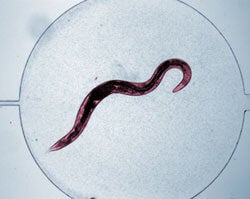
The lessons of a lifetime are powerful, even if that life belongs to a worm. Harvard scientists have developed a microfluidics system so that they can observe the entire lifespan of minute water born animals . These researchers hope their observation will provide important insight into the effects of aging, and diseases like Parkinson’s and Alzheimer’s. According to a paper published on RSC, the microfluidics system allows the Caenorhabditis elegans worms to move as normal without leaving the field of view of cameras and microscopes. Their microfludic cells are sort of the worm equivalent of virtual reality treadmills. Food (in the form of bacteria) comes in, waste is removed, and the worm can swim around. There’s even a special suction system (developed by other teams) to temporarily secure the C. elegans and facilitate close observation or laser microsurgery. The microfluidics system has many different chambers so that a large number of worms can be observed while still tracking the individual identity of each one. In short, Harvard’s created a means to completely observe the entire life of an animal, and it may lead to some remarkable insights in biology.
The Harvard work is touted as medical. Observations of minute changes in swimming activity, body size, and other signs of health will allow researchers to understand how aging affects not only body chemistry but also activity. That sort of understanding could direct studies on mice, primates, right up to humans. Researchers believe that learning from worms is an important step in learning about human aging and nerve disorders. We’ve seen similar connections drawn between experiments with worms and conclusions in humans for substances like resveratrol. They are probably more tenuous than researchers would care to believe.
I think the greater implication of the Harvard work is that these scientists have created one of the first full life-logging systems for a statistically large number of animals all at once (about 16). Imagine the same in humans, you could observe an entire office; the complete life of each inhabitant. That’s a far way off for now, but if microfluidics is the answer for worms, there could be similar answers for higher order organisms. Remember that these worms are moving their bodies freely (swimming in different directions) without leaving their chambers. It really is like a VR environment for them.
Of course, humans are familiar with the life-logging concept, though it has yet to reach the level of observation we’ve seen for animals in laboratory settings. We are moving into an age of constant social networking, flickr, and YouTube. The upcoming generation may be some of the first who’s life has more recorded moments than not. That’s going to lead to a huge amount of data about how humans age. Until that time, we can learn similar information about lower animals but in a much shorter time span. The Harvard microfluidics system, and the work with C. elegans, gives some truly unique insight into the life of animals start to finish. Pretty cool stuff.
[photo credit: RSC]


